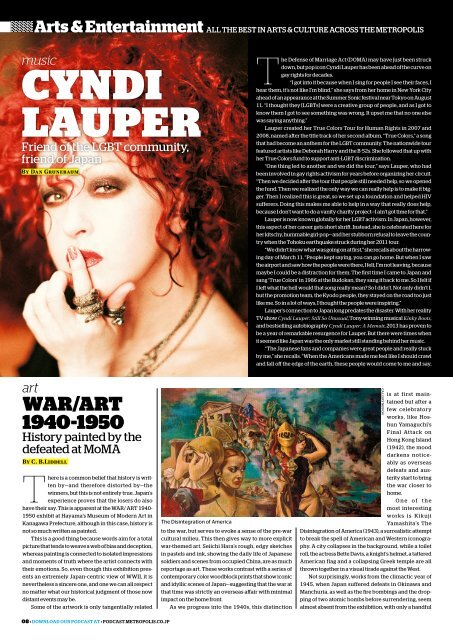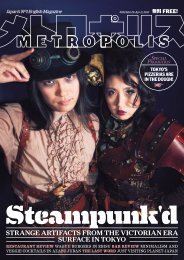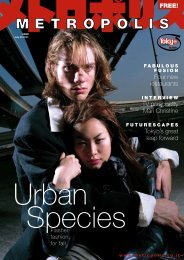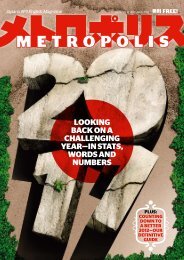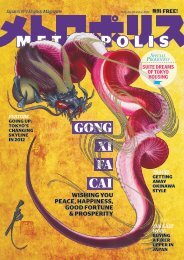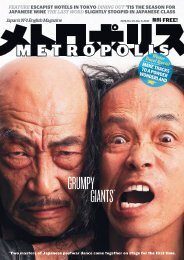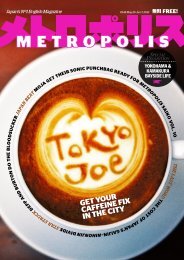1008 July 19-Aug 1, 2013 - Metropolis
1008 July 19-Aug 1, 2013 - Metropolis
1008 July 19-Aug 1, 2013 - Metropolis
You also want an ePaper? Increase the reach of your titles
YUMPU automatically turns print PDFs into web optimized ePapers that Google loves.
Arts & Entertainment ALL THE BEST IN ARTS & CULTURE ACROSS THE METROPOLIS<br />
music<br />
CYNDI<br />
LAUPER<br />
Friend of the LGBT community,<br />
friend of Japan<br />
By Dan Grunebaum<br />
The Defense of Marriage Act (DOMA) may have just been struck<br />
down, but pop icon Cyndi Lauper has been ahead of the curve on<br />
gay rights for decades.<br />
“I got into it because when I sing for people I see their faces, I<br />
hear them, it’s not like I’m blind,” she says from her home in New York City<br />
ahead of an appearance at the Summer Sonic festival near Tokyo on <strong>Aug</strong>ust<br />
11. “I thought they [LGBTs] were a creative group of people, and as I got to<br />
know them I got to see something was wrong. It upset me that no one else<br />
was saying anything.”<br />
Lauper created her True Colors Tour for Human Rights in 2007 and<br />
2008, named after the title track of her second album, “True Colors,” a song<br />
that had become an anthem for the LGBT community. The nationwide tour<br />
featured artists like Deborah Harry and the B-52s. She followed that up with<br />
her True Colors fund to support anti-LGBT discrimination.<br />
“One thing led to another and we did the tour,” says Lauper, who had<br />
been involved in gay rights activism for years before organizing her circuit.<br />
“Then we decided after the tour that people still needed help, so we opened<br />
the fund. Then we realized the only way we can really help is to make it bigger.<br />
Then I realized this is great, so we set up a foundation and helped HIV<br />
sufferers. Doing this makes me able to help in a way that really does help,<br />
because I don’t want to do a vanity charity project—I ain’t got time for that.”<br />
Lauper is now known globally for her LGBT activism. In Japan, however,<br />
this aspect of her career gets short shrift. Instead, she is celebrated here for<br />
her kitschy, hummable girl-pop—and her stubborn refusal to leave the country<br />
when the Tohoku earthquake struck during her 2011 tour.<br />
“We didn’t know what was going on at first,” she recalls about the harrowing<br />
day of March 11. “People kept saying, you can go home. But when I saw<br />
the airport and saw how the people were there, I felt, I’m not leaving, because<br />
maybe I could be a distraction for them. The first time I came to Japan and<br />
sang ‘True Colors’ in <strong>19</strong>86 at the Budokan, they sang it back to me. So I felt if<br />
I left what the hell would that song really mean? So I didn’t. Not only didn’t I,<br />
but the promotion team, the Kyodo people, they stayed on the road too just<br />
like me. So in a lot of ways, I thought the people were inspiring.”<br />
Lauper’s connection to Japan long predates the disaster. With her reality<br />
TV show Cyndi Lauper: Still So Unusual, Tony-winning musical Kinky Boots,<br />
and bestselling autobiography Cyndi Lauper: A Memoir, <strong>2013</strong> has proven to<br />
be a year of remarkable resurgence for Lauper. But there were times when<br />
it seemed like Japan was the only market still standing behind her music.<br />
“The Japanese fans and companies were great people and really stuck<br />
by me,” she recalls. “When the Americans made me feel like I should crawl<br />
and fall off the edge of the earth, these people would come to me and say,<br />
art<br />
WAR/ART<br />
<strong>19</strong>40-<strong>19</strong>50<br />
History painted by the<br />
defeated at MoMA<br />
By C. B.Liddell<br />
There is a common belief that history is written<br />
by—and therefore distorted by—the<br />
winners, but this is not entirely true. Japan’s<br />
experience proves that the losers do also<br />
have their say. This is apparent at the WAR/ ART <strong>19</strong>40-<br />
<strong>19</strong>50 exhibit at Hayama’s Museum of Modern Art in<br />
Kanagawa Prefecture, although in this case, history is<br />
not so much written as painted.<br />
This is a good thing because words aim for a total<br />
picture that tends to weave a web of bias and deception,<br />
whereas painting is connected to isolated impressions<br />
and moments of truth where the artist connects with<br />
their emotions. So, even though this exhibition presents<br />
an extremely Japan-centric view of WWII, it is<br />
nevertheless a sincere one, and one we can all respect<br />
no matter what our historical judgment of those now<br />
distant events may be.<br />
Some of the artwork is only tangentially related<br />
The Disintegration of America<br />
to the war, but serves to evoke a sense of the pre-war<br />
cultural milieu. This then gives way to more explicit<br />
war-themed art. Seiichi Hara’s rough, edgy sketches<br />
in pastels and ink, showing the daily life of Japanese<br />
soldiers and scenes from occupied China, are as much<br />
reportage as art. These works contrast with a series of<br />
contemporary color woodblock prints that show iconic<br />
and idyllic scenes of Japan—suggesting that the war at<br />
that time was strictly an overseas affair with minimal<br />
impact on the home front.<br />
As we progress into the <strong>19</strong>40s, this distinction<br />
is at first maintained<br />
but after a<br />
few celebratory<br />
works, like Hoshun<br />
Yamaguchi’s<br />
Final Attack on<br />
Hong Kong Island<br />
(<strong>19</strong>42), the mood<br />
darkens noticeably<br />
as overseas<br />
defeats and austerity<br />
start to bring<br />
the war closer to<br />
home.<br />
One of the<br />
most interesting<br />
works is Kikuji<br />
Yamashita’s The<br />
Disintegration of America (<strong>19</strong>43), a surrealistic attempt<br />
to break the spell of American and Western iconography.<br />
A city collapses in the background, while a toilet<br />
roll, the actress Bette Davis, a knight’s helmet, a tattered<br />
American flag and a collapsing Greek temple are all<br />
thrown together in a visual tirade against the West.<br />
Not surprisingly, works from the climactic year of<br />
<strong>19</strong>45, when Japan suffered defeats in Okinawa and<br />
Manchuria, as well as the fire bombings and the dropping<br />
of two atomic bombs before surrendering, seem<br />
almost absent from the exhibition, with only a handful<br />
GALLERY NIPPON<br />
08 • DOWNLOAD OUR PODCAST AT • PODCAST.METROPOLIS.CO.JP


